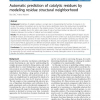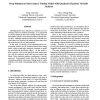170 search results - page 19 / 34 » Modeling and analyzing NBTI in the presence of Process Varia... |
BMCBI
2008
13 years 7 months ago
2008
Background: In addition to their use in detecting undesired real-time PCR products, melting temperatures are useful for detecting variations in the desired target sequences. Metho...
BMCBI
2010
13 years 7 months ago
2010
Background: Prediction of catalytic residues is a major step in characterizing the function of enzymes. In its simpler formulation, the problem can be cast into a binary classific...
DATE
2008
IEEE
14 years 2 months ago
2008
IEEE
Shrinking feature sizes and process variations are of increasing concern in modern technology. It is urgent that we develop statistical interconnect timing models which are harmon...
EMNLP
2010
13 years 5 months ago
2010
We present the first evaluation of the utility of automatic evaluation metrics on surface realizations of Penn Treebank data. Using outputs of the OpenCCG and XLE realizers, along...
EEE
2005
IEEE
14 years 1 months ago
2005
IEEE
UN/CEFACT’s Modelling Methodology (UMM) is used to analyze and design B2B business processes. We extend UMM by a constraint mechanism for adding business environment-specific co...


